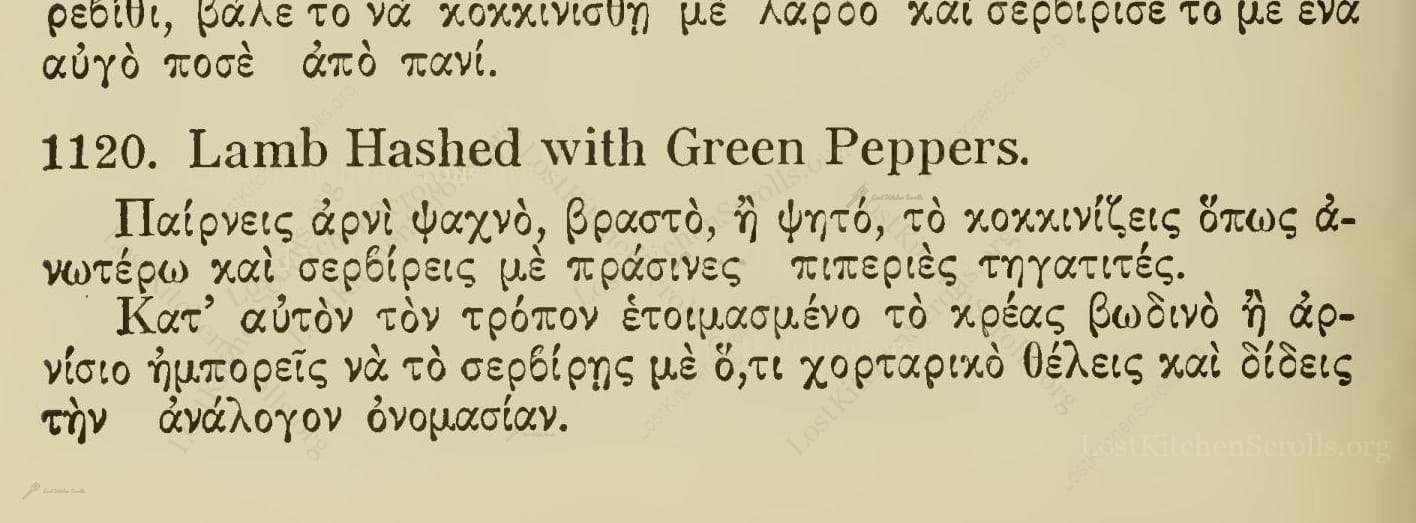
Lamb Hashed With Green Peppers
"Παίρνεις ἀρνὶ ψαχνό, βραστό, ἢ ψητό, τὸ κοκκινίζεις ὅπως ἀνωτέρω καὶ σερβίρεις μὲ πράσινες πιπεριὲς τηγανιτές. Κατ' αὐτὸν τὸν τρόπον ἑτοιμασμένο τὸ κρέας βωδινὸ ἢ ἀρνίσιο ἠμπορεῖς νὰ τὸ σερβίρης μὲ ὅ,τι χορταρικὸ θέλεις καὶ δίδεις τὴν ἀνάλογον ὀνομασίαν."
English Translation
"Take lamb meat, boiled or roasted, brown it as mentioned above, and serve it with fried green peppers. In this way, you can also prepare beef or lamb and serve it with any greens you like, giving it the corresponding name."
Note on the Original Text
The recipe is minimalist, as was common in early 20th-century cookbooks, especially those aimed at home cooks who were expected to fill in the blanks from culinary experience. Step-by-step instructions are truncated, and precise quantities are rarely given—reflecting a culture where thrifty use of leftovers and improvisation ruled. The Greek original employs period spelling and vocabulary—ψαχνό (psachno) meaning meat without bone, and references to πιπεριές (piperiés), green peppers, which might not have been common in all Greek regions at the time, but were embraced in the diaspora.

Title
Megale amerikanike mageirike dia mageirous kai oikogeneias (1917)
You can also click the book image above to peruse the original tome
Writer
Michael Gkines
Era
1917
Publisher
Ekdotika Katastemata
Background
A sumptuous journey through early 20th-century Greek-American kitchens, this cookbook offers practical and time-tested recipes for savory dishes and delightful sweets—each crafted to suit the American system, yet infused with Greek tradition. A perfect companion for both family cooks and aspiring chefs.
Kindly made available by
Internet Archive
This recipe hails from a 1917 Greek-American cookbook published in New York, tailored for Greeks adapting their cuisine to available American ingredients and cooking styles. The cookbook represents a practical blending of old country traditions and new world adaptations after immigration—an edible bridge through time and place. The recipe itself is a simple, comforting dish: a leftover solution for using cooked lamb, familiar to many households, and brightened with green peppers, perhaps reflecting the wider variety of vegetables encountered in American markets.

Originally, the tools were basic and robust: a heavy frying pan or sauté pan, a knife for slicing meat and peppers, and a sturdy wooden spoon for turning the hash. Cooking would have been done over a stove or open flame, with olive oil or rendered animal fat for frying. Simple serving platters or shallow bowls would have completed the presentation, highlighting the family-style approach to meals.
Prep Time
10 mins
Cook Time
15 mins
Servings
4
We've done our best to adapt this historical recipe for modern kitchens, but some details may still need refinement. We warmly welcome feedback from fellow cooks and culinary historians — your insights support the entire community!
Ingredients
- 1 pound cooked lamb (boiled or roasted)
- 2-3 green bell peppers (about 7 ounces)
- 2 tablespoons olive oil (for frying, optional, as substitute for historical fats)
- Salt and pepper to taste
- Optional: 7 ounces cooked seasonal greens or vegetables (e.g. spinach, chard, or purslane)
Instructions
- Begin with approximately 1 pound (16 ounces) of cooked lamb meat, either boiled or roasted, cut into bite-sized pieces.
- In a large frying pan, reheat the lamb gently, allowing it to brown slightly for extra flavor—much as you would a hash, turning it to coat all sides (add a little olive oil if necessary).
- Separately, slice 2-3 fresh green bell peppers (about 7 ounces total) into strips and fry them in olive oil until they are soft and fragrant, taking care not to burn them.
- Once both the lamb and peppers are ready, plate the lamb and top with the fried green peppers.
- Optionally, you may serve the meat alongside or atop any cooked seasonal greens or vegetables you desire.
Estimated Calories
350 per serving
Cooking Estimates
This recipe takes about 10 minutes to prepare and 15 minutes to cook, since the lamb is already cooked in advance. Each serving contains about 350 calories, and the recipe makes 4 servings.
As noted above, we have made our best effort to translate and adapt this historical recipe for modern kitchens, taking into account ingredients nowadays, cooking techniques, measurements, and so on. However, historical recipes often contain assumptions that require interpretation.
We'd love for anyone to help improve these adaptations. Community contributions are highly welcome. If you have suggestions, corrections, or cooking tips based on your experience with this recipe, please share them below.
Join the Discussion
Rate This Recipe
Dietary Preference
Main Ingredients
Occasions

Den Bockfisch In Einer Fleisch Suppen Zu Kochen
This recipe hails from a German manuscript cookbook compiled in 1696, a time whe...

Die Grieß Nudlen Zumachen
This recipe comes from a rather mysterious manuscript cookbook, penned anonymous...

Ein Boudain
This recipe comes from an anonymous German-language manuscript cookbook from 169...

Ein Gesaltzen Citroni
This recipe, dating from 1696, comes from an extensive anonymous German cookbook...
Browse our complete collection of time-honored recipes



